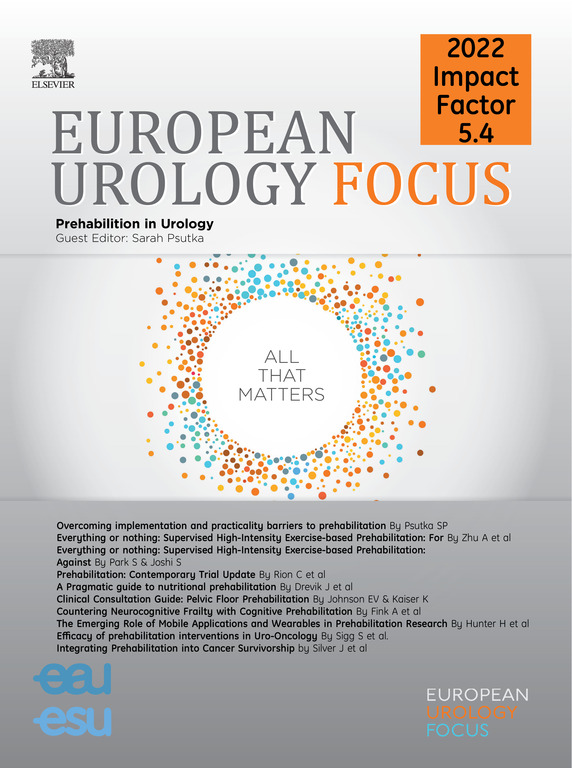机器人泌尿外科在临床实践中从无到有的演变:GRAND 研究注册的结果。
IF 5.6
2区 医学
Q1 UROLOGY & NEPHROLOGY
引用次数: 0
摘要
背景和目的:由于缺乏高质量的证据,与腹腔镜手术或开腹手术相比,主要的泌尿外科指南目前并不推荐机器人辅助手术。我们旨在提供机器人泌尿外科发展的真实数据,并将其与腹腔镜手术和开腹手术的围手术期结果进行比较:我们使用了联邦统计局研究数据中心提供的GeRmAn全国住院患者数据(GRAND)(2005-2021年),并进行了多项患者层面的分析。我们纳入了接受大型泌尿外科手术的患者,并报告了该领域最大规模的研究,共993 276名患者:733 416 例患者采用开腹手术,109 428 例采用腹腔镜手术,150 432 例采用机器人辅助手术。总体而言,442 811 例(45%)患者接受了根治性前列腺切除术,129 943 例(13%)接受了根治性膀胱切除术,192 340 例(19%)接受了根治性肾切除术,123 648 例(12%)接受了肾部分切除术,56 114 例(5.6%)接受了肾切除术,48 420 例(4.9%)接受了肾盂成形术。在过去几年中,接受机器人辅助手术的患者人数呈指数增长,而接受开放手术的患者人数则大幅减少。接受微创手术的患者的基线特征稍好,但临床意义不大。在多变量回归分析中对主要风险因素进行调整后,机器人手术与开放式手术相比,在所有五种主要肿瘤手术中,机器人手术的死亡率明显较低,在所有六种主要泌尿外科手术中,机器人手术与开放式手术相比,入重症监护室、输血和住院时间较短:结论和临床意义:机器人手术正成为泌尿外科主要手术的主流。本文章由计算机程序翻译,如有差异,请以英文原文为准。
Evolution of Robotic Urology in Clinical Practice from the Beginning to Now: Results from the GRAND Study Register
Background and objective
Major urological guidelines do not currently recommend robot-assisted surgery compared with laparoscopic or open surgery due to the lack of high-quality evidence. We aimed to provide real-world data on the evolution of robotic urology and to compare its perioperative outcomes with those of laparoscopic and open surgeries.
Methods
We used the GeRmAn Nationwide inpatient Data (GRAND), provided by the Research Data Center of the Federal Bureau of Statistics (2005–2021), and performed multiple patient-level analyses. We included patients undergoing major urological surgeries and report the largest study in the field with 993 276 patients.
Key findings and limitations
An open approach was performed in 733 416 cases, a laparoscopic approach in 109 428, and a robot-assisted approach in 150 432. Overall, 442 811 (45%) patients underwent radical prostatectomy, 129 943 (13%) radical cystectomy, 192 340 (19%) radical nephrectomy, 123 648 (12%) partial nephrectomy, 56 114 (5.6%) nephroureterectomy, and 48 420 (4.9%) pyeloplasty. The number of patients undergoing robot-assisted surgery increased exponentially, while the number of patients undergoing open surgery decreased substantially throughout the past few years. Patients undergoing minimally invasive surgery displayed slightly better, but clinically insignificant, baseline characteristics. After adjusting for the major risk factors in the multivariate regression analysis, robotic versus open surgery was associated with significantly lower odds of mortality for all five major oncological surgeries and with lower odds of intensive care unit admission, transfusion, and length of hospital stay for all six major urological surgeries.
Conclusions and clinical implications
Robotic surgery is becoming the mainstay in major urological operations.
Patient summary
Patients selected for robotic surgery in Germany presented better perioperative outcomes compared to those operated with an open approach.
求助全文
通过发布文献求助,成功后即可免费获取论文全文。
去求助
来源期刊

European urology focus
Medicine-Urology
CiteScore
10.40
自引率
3.70%
发文量
274
审稿时长
23 days
期刊介绍:
European Urology Focus is a new sister journal to European Urology and an official publication of the European Association of Urology (EAU).
EU Focus will publish original articles, opinion piece editorials and topical reviews on a wide range of urological issues such as oncology, functional urology, reconstructive urology, laparoscopy, robotic surgery, endourology, female urology, andrology, paediatric urology and sexual medicine. The editorial team welcome basic and translational research articles in the field of urological diseases. Authors may be solicited by the Editor directly. All submitted manuscripts will be peer-reviewed by a panel of experts before being considered for publication.
 求助内容:
求助内容: 应助结果提醒方式:
应助结果提醒方式:


